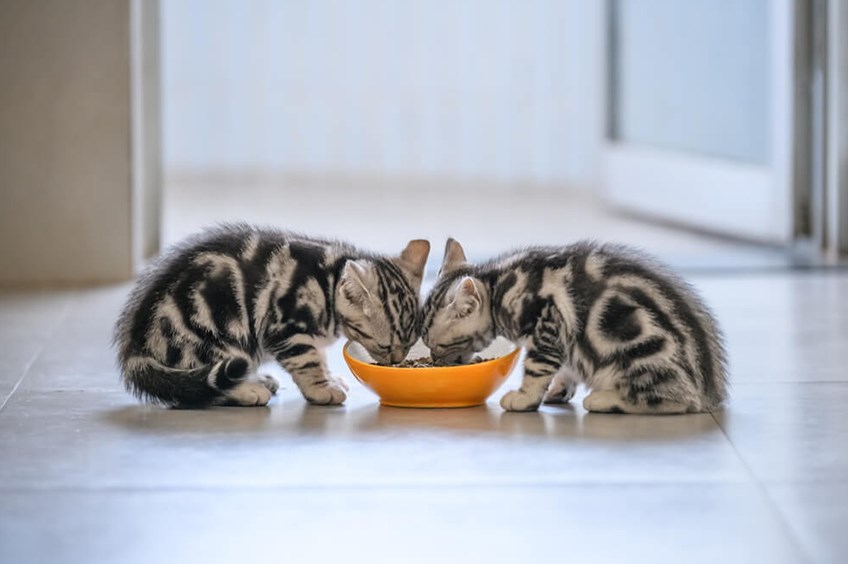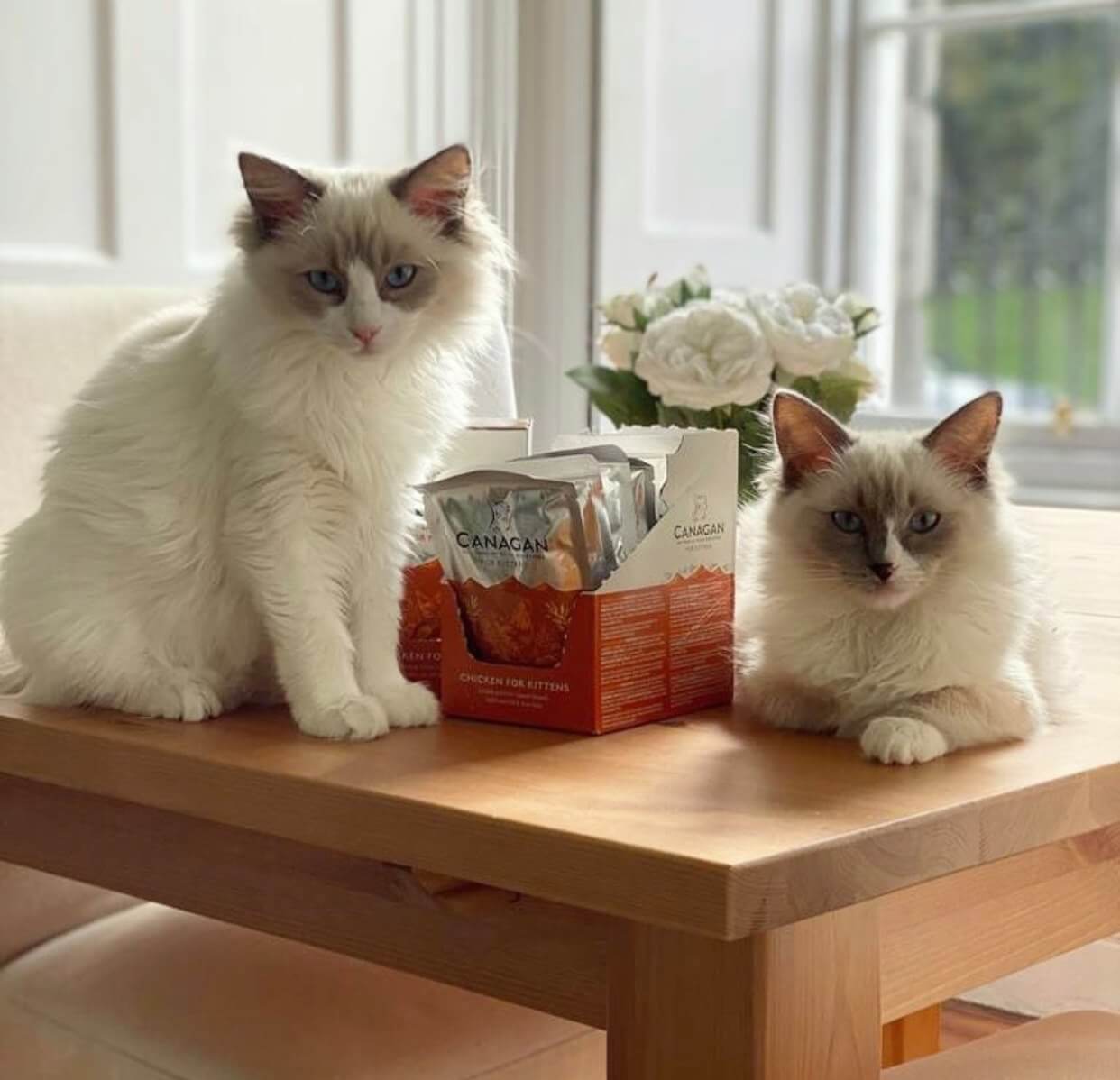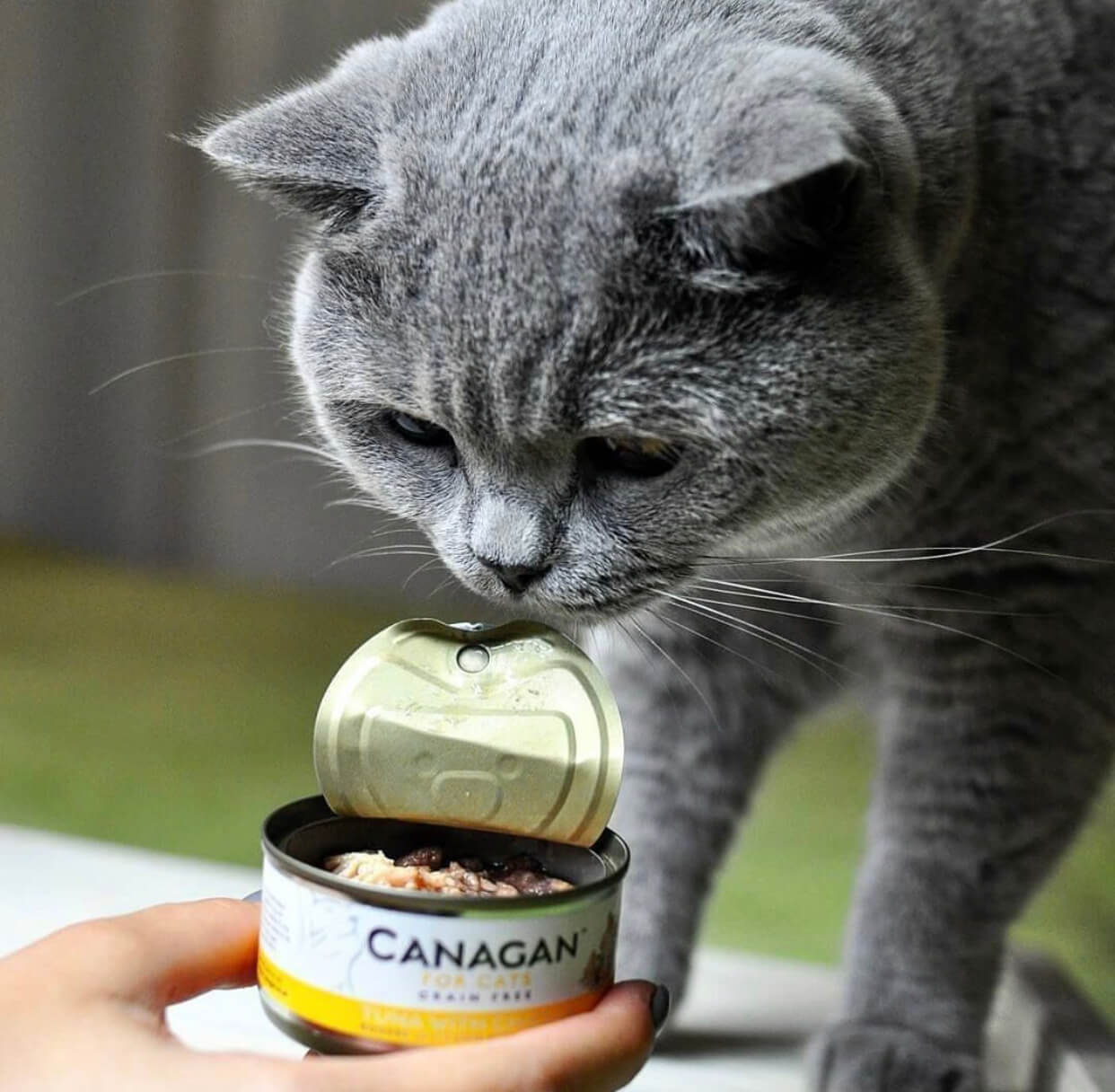A guide to feeding your kitten
Published date: 21 March 2022

Credit: Shutterstock
Welcoming a new kitten into your family and home is an exciting time; if you’re new to the process it can also be a life-long learning experience too, as we get to know all about our companions and how to care for them and their individual requirements.
Finding the right diet for your feline certainly is top of the list when it comes to caring for your cat, the benefits of a good diet are countless. If you’re expecting a new kitten or have recently welcomed one home, then you’re in the right place and in safe hands with Canagan, the home to natural grain-free pet food.
Our delicious cat recipes are perfect for kittens as well as adults (from weaning onwards). Just like in the wild, where the kittens of the clutter and the adults shared the same food in different quantities it is the same when feeding Canagan.
All our recipes feature an adult and kitten feeding guide so all the cats in the house, young and old, can enjoy the same delicious meals.
WHAT SHOULD I FEED MY KITTEN?
Though small and spritely, our kits are growing at a fast rate and require a food that will support their muscles, bones, internal organs, teeth, fur and even their brain function. By ensuring we find a high quality and suitable diet early on, we not only set them on a good path for the future, but the food has huge health and psychological benefits.
Our cats are obligate carnivores, which means that they are built for a meat-based diet; because of this, they have different requirements compared with dogs and humans. They cannot transform amino acids found in plants and are therefore not able to survive on a plant-based diet.
A healthy kitten food should contain a proper balance of protein, carbohydrates, vegetables, fats and an inclusion of vitamins and mineral supplements which all play a role in the health and wellbeing of your cat:
- Protein - Important to help your kitten with growth and repair of the muscles and tissues, assists the body in creating hormones and enzymes and helps to provide energy. When it comes to protein, the quality is important, and whilst humans and dogs can adapt to a lower protein diet, cats have a much higher protein requirement. Our felines must be able to access a number of specific amino acids: taurine, arginine, methionine and cysteine. Dogs and humans can convert and use other amino acids from plants, but cats cannot and therefore will need to obtain them from good quality animal protein.
- Fats - Healthy fats play an important role in our companion’s body, necessary for the normal development and function of muscle, nerves, cells and tissues. Not only this but fats help the body to absorb vitamins. A healthy and high-quality fat source in your friend’s food will contribute to healthy skin and coat, giving them a glossy shine as a result, again for cats this will need to come from animals-origin.
- Carbohydrates - Cats have a reduced ability to utilise carbohydrates but that doesn’t mean they can’t use and digest it when we choose their carbohydrate sources carefully. It is a great source of energy for your kitten but also there to help provide fibre, which will assist in digestion and absorption. Just like protein, the carbohydrate source is important, if the quality is low it could result in digestive issues, and lead to food intolerances or allergies. A high-quality carbohydrate will provide your friend with slow-release energy through the day.
- Vegetables - Rich in fibre, minerals, antioxidants, enzymes and Phyto-nutrients, vegetables are a friendly additive to your kitten’s diet. Especially as what they can offer is not found in meat.
- Vitamins & Minerals - Found naturally in most ingredients, vitamins and minerals play different roles in the body, from immune support through to brain function. A good cat food will ensure that all of these are available to our felines at the correct level.
At Canagan, we not only have over 30 years of experience working within the pet food industry; but we are proud to say that we work with some of the world’s top nutritionists. Together, we ensure that we are offering our companion’s the very best, from kittens through to their wiser years.

HOW OFTEN SHOULD I FEED MY KITTEN?
Kittens have small stomachs, so it’s best to feed them little and often. We recommend feeding your new friend four meals a day until they are around six months old, if it suits you better in your household you can then move to feeding twice day, once in the morning and once in the evening.
It’s important to remember that all cats are different, and their individual needs may differ, which will dictate when you feed them. We also appreciate that your schedule may not suit this lifestyle, however where possible, spacing your friend’s food out at a younger age is preferable.
Consistency is key! Keeping to a routine will be best for them and for you.
WHAT FOODS SHOULD MY KITTEN AVOID?
In order to grow a healthy relationship in your home with your new companion, it’s important to set out rules and guidelines within the family so that training is consistent, and table scraps aren’t passed a long whilst you’re eating.
Not feeding titbits at the table will help with bad habits and the possibility of picking up potentially dangerous snacks, the below are items that should be avoided at all costs:
- Onions, Garlic and Chives
- Chocolate
- Xylitol (Artificial Sweetener)
- Cooked Bones
- Alcohol
- Grapes and Raisins
- Tea and Coffee
If any of these are consumed, even in small amounts it could be fatal – so please contact your vet immediately if they have been eaten.
Don’t worry, it’s okay to feed your kitten treats (that are safe to them) so long as those treats only make up around 10% of their diet. Be sure to reduce mealtimes when you have been using treats in the day. We’ve outlined some other potentially dangerous foods below, that are quite often popular amongst pet owners:
- Raw meat or live - best avoided as could contain parasites and bacteria
- Raw eggs – harmful if Salmonella is present and can slow down the absorption of vitamin B
- Raw fish – again, may lead to a vitamin B deficiency with some serious side effects
- Milk – contrary to popular belief, milk isn’t the best option for your cat and can cause diarrhoea
As your friend is an individual, it’s important to remember that one cat may be affected differently by certain items than another. At Canagan, we say it’s best to be safe – keep human food out of reach, just in case!
WHY CHOOSE CANAGAN FOR YOUR KITTEN?
Our delicious recipes are made for all lifestages, which means that kittens can enjoy our diet all the way through to their twilight years. Canagan contains a very high meat content, and most of our range (with the exception of Senior/Light) have sufficient levels of nutrition to maintain a kitten’s growth. We believe in feeding our companions as they would in their natural environment – the wild; if we think of a cat’s ancestral diet, kittens and adults would have fed on the same food; just in different quantities. With Canagan, these principles remain the same.
The protein and fat levels in Canagan are much higher than those found in most carbohydrate packed adult dry foods, or even kitten foods and the nutrient levels in our diets are more than sufficient for our young companions; the calcium and phosphorus levels are also well suited to the development of kittens – and all of the nutritional requirements discussed in this blog are met within our diets.

At Canagan, we pride ourselves on working with some of the world’s top nutritional experts and this family run business is home to many years of experience in companion care. We believe that food should be natural, and that’s why we preserve our diets with Vitamin E, you won’t find any chemical preservatives in Canagan which can be used in other popular brands.
HOW DO I MOVE OVER TO CANAGAN?
You can feed your kitten Canagan from weaning onwards, we recommend moving over slowly, reducing the amount of the old food and slowly increasing the amount of Canagan.
On day one mix 25% Canagan with 75% of the previous food. On day three make it 50% of each. Day five is 75%, working up to 100% of Canagan on day seven.
Remember, the first few days of moving into a new home is very exciting for a cat. It’s best to let your new family member settle in first and then start the changeover of their food. Excitement and nervousness could show itself in a runny stool or not digesting their food properly and vomiting may occur, just take it slowly and let your kit adjust to their new life before making big changes. If you would like more support, you are welcome to contact us - we would be happy to hear from you.
HOW MUCH SHOULD I FEED MY KITTEN?
Don’t worry, we’ve put a feeding guide on every bag to suit junior and adult requirements. You may notice that your kitten’s food intake will slowly increase until they’re almost fully grown; before it decreases to meet their feeding requirements for maintenance once they are adults.
Feeding a healthy diet to our kitten will show in their health and their temperament, this includes their stool. We’re looking for a firm stool, one that is easy to pick up; a sloppy or soft one could be a sign of over-feeding; if you’re noticing this in your young cat, try reducing your friend’s food slightly to see if this helps.
Of course, just like us, treat intake must be taken out of your kitten’s feeding requirements, so if they’re training through the day and picking up titbits; you will need to consider this when It comes to feeding time.

DRY FOOD VS WET FOOD
You can fuel your kitten’s days with dry, wet or a mixture of both! Feeding wet only tends to be more expensive than the dry option as you will be required to feed more. Some Canagan feeders decide to feed both wet and dry to their companion, this is a very popular and a delicious option.
When feeding both you simply work with percentages. If you wanted to feed 50/50 you would cut our recommended amount of wet by 50% and the dry by 50% and feed. This then works for 25% vs 75% and so on.
Feeding cats, a mixed diet of both wet and dry is extremely beneficial, due to their tendency to drink less water than our canine friends. If you’re concerned about your cat’s water consumption, we recommend speaking with your local pet specialist as they may be able to suggest support in the form of a water fountain, and or offer helpful advice.

DO YOU HAVE ANY GENERAL FEEDING TIPS FOR OUR KITTEN?
- Cats like to eat little and often and though it may be tempting to leave their dry food out all day, this could lead to obesity. If your cat is safe nibbling through the day, great but if not; consider feeding multiple small meals and don’t be too concerned if they don’t finish up the whole plate, it’s likely they will come back later.
- If your kitten isn’t eating, try adding a little hot water to the food and letting it cool – this will cook the fats and smell delicious. You can also try removing your companion’s bowl after an hour of not eating and replacing it at the next mealtime. If you suspect that your kitten’s fussiness is more serious, please contact your vet for advice.
- Keep your bowls clean, cats enjoy a clean environment. If your cat isn’t eating, it could be down to the cleanliness of the bowls or the placement; make sure their food and water are not placed near busy areas or say a litter tray.
- As mentioned above, if your kit isn’t drinking enough water, we recommend trying a water fountain in your home as cats seem to prefer fresh, flowing water.
- Watch their weight! Especially after your cat has been spayed/neutered, where research has shown that cats may become hungrier. We have a diet to help, which you can find on our website, if you require advice, please contact us to chat.
- Store your food in dry and cool conditions, sealing our bag up to keep it nice and fresh.
- Be consistent and try to feed your pet at the same time every day.
As a last note, we would like to remind you that a healthy diet and lifestyle is really important to our companion’s quality of life, now and in preparation as an adult. Studies show that over 44% of the UK’s cat population is overweight or obese, weight gain can have huge detrimental effects on our friends.
Be responsible and choose a high-quality food for your kitten and check their health and weight regularly. You can do this by popping to your local pet shop to use their scales and by checking your friend visually, by running your hands along their sides and chest; you should be able to feel their ribs through a layer of fat. If you’re unsure you can follow a feline body score chart or speak with your vet or local pet specialist.
Lastly, we would like to wish you the very best on this new journey with your companion. Exciting times and a true friendship await you both and we look forward to fuelling every step of the adventure that’s ahead.
*The content is not intended to be a substitute for professional medical advice, diagnosis, or treatment. Always seek the advice of your veterinarian or other qualified pet health provider with any questions you may have regarding your pet’s health*




Comments
There are currently no comments, be the first to comment.